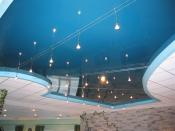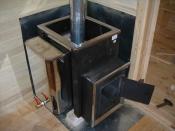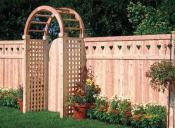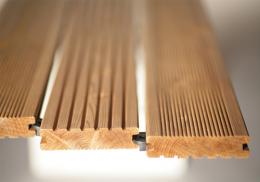Search
Login
Thermal tree or terrace board: technology for obtaining a terrace board, the use of a terrace board.
They tried to improve the qualitative characteristics of the tree in distant times. The Vikings, making the wood blanks more durable, scorched the wood with fire. The Slavs soaked and boiled thin strips of wood, using them in the future for the manufacture of household dishes. The Indians, to give greater strength to their guns, burned the ends of the spears on an open fire. Mankind, having analyzed the knowledge and skill of previous generations, has achieved, in modern conditions, very great successes in obtaining the so-called hardened tree.
Content
- Properties of thermally modified wood video
- Wood processing technology
- The use of thermal wood
- Tan color for different types of wood video
Properties of thermally modified wood
To become practically invulnerable to moisture and bugs of bark beetles, the wood is heat treated. It is currently treated, not with fire, but with supersaturated steam of high temperature. The result of this processing are new properties of a conventional board. Such thermally modified wood is an environmentally friendly material, has a number of unique properties:
- reduced, at the level of 4-8%, humidity;

- resistance to decay, since due to high processing temperatures, polysaccharides decompose in the tree and this against the background of low equilibrium humidity makes reproduction of fungus, mold and any microorganisms impossible;
- a unique property of thermal wood, which, as a result of operation, allows you to save (regardless of temperature and humidity changes) the product geometry without changes;
- cheap types of wood, after processing, acquire the appearance of an old tree of exotic species and any shades are obtained, regardless of the type of wood, from light yellow to almost black to the entire depth of the product;

- by improving the thermal insulation properties of wood by 30%, the thermal tree is an ideal material for saunas, baths, and inner lining of houses;
- low hygroscopicity, since moisture absorption is reduced by 5 times;
- reduced heat conductivity, high density of the tree structure;
- lighter weight compared to wood dried in natural conditions or drying chambers;
- low resin content in coniferous species;
- biological durability;
- environmental friendliness, since during heat treatment, no chemical additives are used, but only steam and temperature. Simply put, as a result of heat treatment, ordinary boards do not rot, do not blacken, do not deform, do not swell and do not dry out.
Wood processing technology
There are several technologies to achieve this quality board:
Dutch, French, German, Finnish.
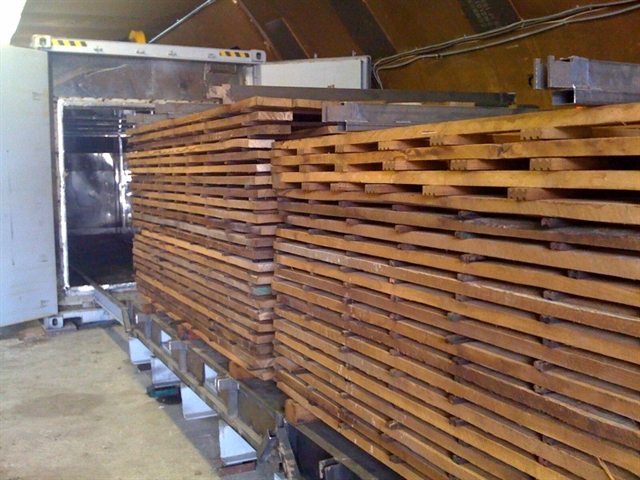
Production thermal wood, is the result of thermohydrolysis of wood in conditions of limited air access in the atmosphere of water vapor, at a temperature of from 150 to 240 degrees.
french processing technology
The French, in the production of thermal wood, undergo a series of successive operations of high-temperature drying of wood of natural moisture, thermal modification and cooling of wood in the chamber, in the atmosphere of water vapor and gases released from the wood.
When drying and thermal modification of wood, an excess of steam and air emissions is formed, they are utilized by burning in a gas burner.
There is another French technology. It is based on the use of nitrogen as a protective medium instead of water vapor. Thermal modification itself occurs at a temperature of 200 to 260 degrees Celsius, the whole process lasts from 7 to 16 hours.
processing technology of Dutch companies
The technology of Dutch companies is a multi-stage moisture-heat-pressure treatment, carried out as a result of cyclic thermohydrolysis of wood at a temperature of 150-180 degrees Celsius, pressure up to 1.6 MPa.
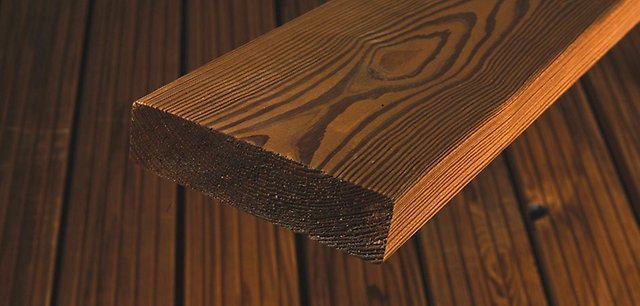
In the autoclave, several stages of wood processing take place, at first it is heated to the temperature of thermal modification, then it is placed in hot water 150-180 degrees Celsius under strong pressure, then it is cooled and dried. Already dry, it is again heated, then cooled again and it lasts for more than 20 hours.
german processing technology
According to German technology, the tree is cooked in hot oil (linseed, sunflower, rapeseed, etc.). Taking into account the cost of oil, its amount, you can imagine the price of such a thermal board.
finnish thermal wood technology
The company DrevMarket chose Finnish technology for the manufacture of its own thermal wood.
Finnish technology for the manufacture of thermal wood suggests that wood thermal modification be carried out in a protective atmosphere of water vapor at a temperature of 185 degrees to 212 degrees Celsius, while reducing the oxygen content to 3.5%.
The whole process is divided into five stages.
First, the wood is heated at overpressure in a vapor-air atmosphere.
The process of hydrohydrolysis itself occurs in a vapor-air atmosphere, with a slight overpressure.
The third step is to cool the wood to a temperature of 100 degrees, in a vapor-air atmosphere at normal pressure.
Further, the wood is brought to the specified humidity values \u200b\u200b(from 4 to 6%).
The last step is to cool the material to a temperature of 30-40 degrees.
Finnish technology, assumes the total duration of the process, when processing pre-dried wood, about 2-3 days. When using wet material, the thermal modification cycle increases in proportion to the drying time.
The DrevMarket company has the most modern, industrial heat chamber of a Finnish company, has its own production for harvesting, sawing, drying, molded and joiner production, can produce any batch of thermal wood to order.
The use of thermal wood
Thermowood can be used:

- In the interior and exterior decoration of the premises (decorative beams, facade structures, wall panels, ceiling lining, balcony fencing).
- For the manufacture of doors, window sills, stairs, where stability of the product geometry is important.
- For the manufacture of furniture (including countertops, furniture for bathrooms, directly bathtubs and sinks from solid wood, furniture for the interior and garden).

- For finishing baths, saunas, pools, bathrooms, moorings and other objects having direct contact with water.
- For the manufacture of floors and decking.
Tan color for different types of wood
Just as when tanning in the hot sun, by adjusting the time the wood stays in the chamber and the temperature, you can achieve different shades of wood. Color uniformity depends on exposure time. Depending on the use of different species of trees, the processing technology is adjusted. We offer several particularly common options.
Pine.
It is subjected to heat treatment at a temperature of 214 degrees, it is coniferous with a pronounced texture, its color after processing is golden brown.

Pine thermal boards are most often used in the interior (on ceilings and walls), the exterior (on facades, when stitching overhangs, when installing terraces and floorings) and in steam rooms.
Cedar.
It is subjected to heat treatment at a temperature of 214 degrees Celsius, has an exquisite texture. Color is golden brown.

Ideal for interiors (ceilings and walls), exteriors (filing overhangs), paired. Due to its light weight, it is recommended to use for facade structures.
Beech.
Hardwood with the least pronounced texture.

It makes a beautiful terrace board in the noble color of dark mahogany.
Ash.
By its properties and aesthetics, it is an ideal material for heat treatment.

It is distinguished by color uniformity, a bright rich texture, due to the great elasticity of the rock, the absence of hidden and visible defects. This is the most recommended material for facades, terraces, floors and more.
Birch.
This thermal board is an economical option for interior or exterior wall cladding, floor laying.

The thermal birch in dark brown color gives any project the look of expensive exotic species.

